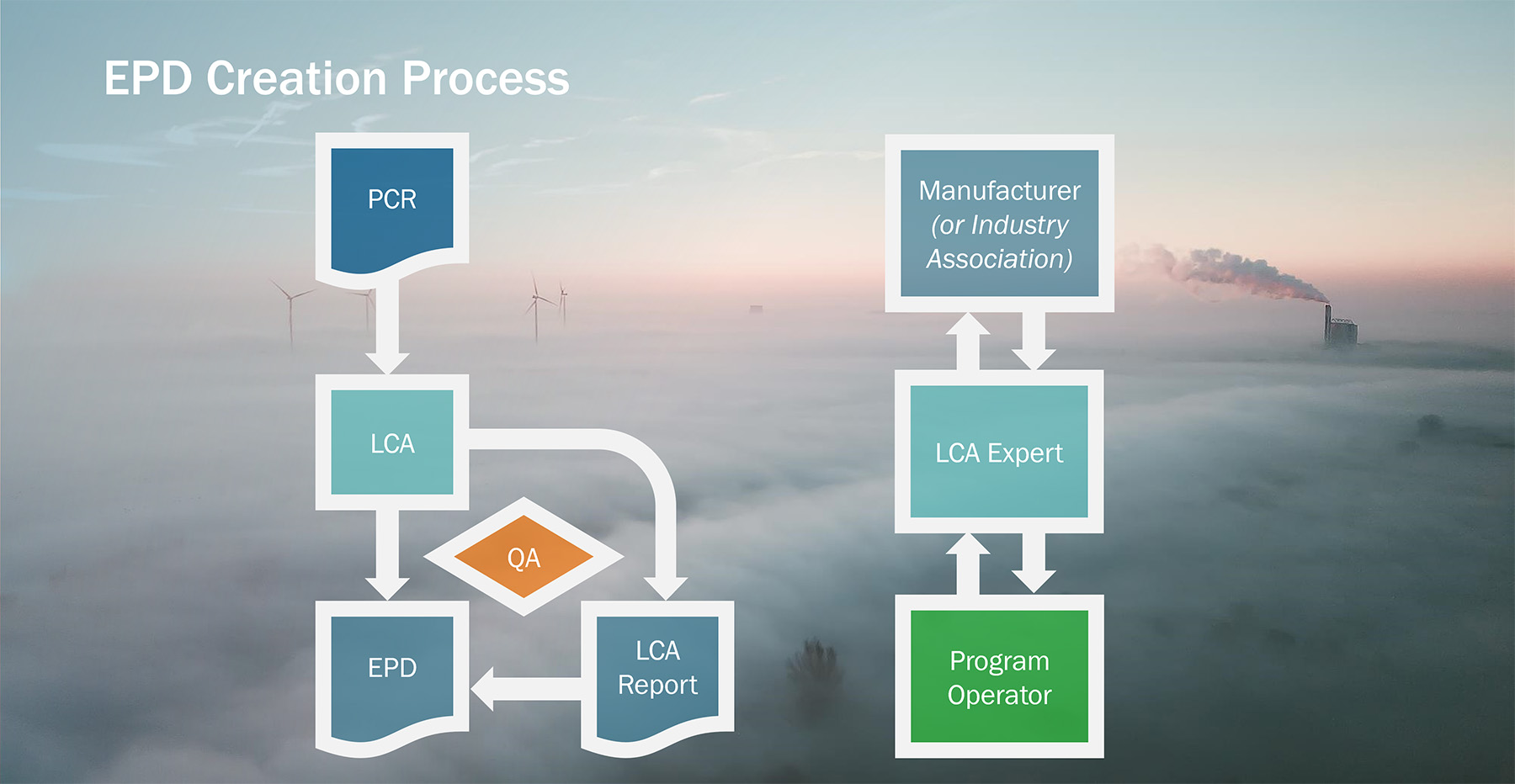In the construction and building materials sector, demand is growing for environmental product declarations (EPDs). An EPD is a report that summarizes a product’s environmental impact. While regulation is a key motivator, the commercial advantages should not be underestimated.
The Benefits of an EPD
An EPD provides verifiable, accurate, transparent environmental information about products and their applications. The EPD is based on the product’s life cycle assessment (LCA), which details the product’s potential environmental impact. This includes all the inputs of energy and resources, as well as the outputs of emissions and waste, during manufacturing, distribution, use-phase and disposal.
EPDs provide a baseline for companies to quantify, communicate and improve the sustainability performance of their products. With cleaner, greener products, businesses contribute to positive change in the construction and building materials sector. Key business benefits include:
Market access: Verifying the product’s environmental parameters in EPDs enables market access to green building programs. They also open the door to procurement for government construction projects through the U.S. General Services Administration (GSA). And EPDs increasingly belong to company-specific sustainability requirements in requests for proposals (RFPs).
Green procurement: Buyers use EPDs to determine how environmentally friendly a product is compared to alternatives. With EPDs, companies can gain a competitive advantage in green public procurement.
Decarbonization tool: The granular information gained during the life cycle assessment for EPDs feeds the overall organizational decarbonization goal.
Supply chain transparency: Ideally, EPDs contain product data specific to the facility and manufacturing processes all along the supply chain.
Competitive edge: In industries such as electronics, EPDs can be used in marketing to underline environmental claims for products.
An additional merit of EPDs is mitigation of burden shifting, when environmental impacts are transferred from one stage to another in the product life. One example of burden shifting is a policy that only focuses on low-emission energy production. Societies may embrace wind or solar power because these technologies do not emit GHG emissions, yet the manufacture of turbines and panels is not emission-free.
The Need for EPDs
Downstream customers and political regulations increasingly demand that manufacturers disclose the environmental performance of their products in a comparable and verifiable way. These disclosures all rely on the environmental transparency provided by EPDs.
Recent legislation and various measures encourage or require EPDs in the construction and building materials sector. Incentives and regulations include the following:
• The U.S. Environmental Protection Agency is providing $100 million in grants in 2024 to enable companies to develop EPDs for materials and products used in construction.
• The U.S. General Services Administration is a pillar for climate action and sustainability under the Inflation Reduction Act of 2022. Last year’s GSA pilot program invested roughly $2 billion in lower embodied carbon (LEC) materials for more than 150 federal building projects. In this context, “embodied” refers to GHG emissions that arise when making building materials such as concrete. EPDs were used to certify that materials met defined thresholds.
• The Buy Clean California Act requires contractors for state building projects to disclose the GHG emissions and embodied carbon impacts of materials such as steel and glass via EPDs.
• The EU Green Public Procurement program contains requirements and voluntary criteria for member states to acquire products that pose the least harm to the environment. EPDs provide clear, verifiable environmental criteria based on the product LCAs.
• The European Commission has agreed to a revised Construction Products Regulation (CPR). Under the revised CPR, for products sold or used in the European market, companies will need to disclose the environmental performance of their construction products using LCAs. This will become an additional requirement within the Declaration of Performance (DoP) and part of the CE marking, which certifies that products have been assessed according to a harmonized European standard.
Green Building Certification
EPDs can serve as a reliable source of information for the comparison and selection of suppliers. Builders seeking to gain certification typically use products with EPDs, which clearly state the environmental impact of materials.
Also, the EPD is a communication format that is integrated into construction workflows and used extensively by green building certification schemes. These include:
• The Leadership in Energy and Environmental Design (LEED) certification from the U.S. Green Building Council, a globally recognized green building rating system.
• The Building Research Establishment Environmental Assessment Method (BREEAM), chiefly used in the U.K. to assess, rate and certify the sustainability of buildings.
• The DGNB International, Germany’s green building certification, which takes the LCA, holistic sustainability and performance, as well as economic aspects, into account.
How to Create an EPD
As mentioned, the LCA is the basis for an EPD report. However, companies need to conduct assessments according to specific standards, or product category rules (PCRs). These ensure that functionally similar products are all assessed in a similar way when conducting the LCAs.
Companies that are just starting their sustainability journey typically hire experts to conduct their product LCAs and create their EPDs. Advanced companies that have committed to evaluating most or all of their products via LCA have on-staff practitioners who perform LCAs using software tools and data.
These practitioners also rely on various roles in the company to provide the necessary data. These include engineering, plant management, design, procurement & supply chain, finance, marketing, and environment, health & safety. These are the teams that have the data required to conduct an LCA and support EPD creation.
Program operators are independent agencies that oversee the full EPD creation process in accordance with ISO 14025 guidelines from the International Standards Organization. These guidelines state that all EPDs must also be verified by an authorized, independent third party before they can be registered and published on the portal of the selected EPD program operator.

Source: Sphera
Challenges to EPD Creation
Creating an EPD for the first time tends to be complex and time-consuming. One of the biggest hurdles is getting supplier data for the LCA. Additionally, the third-party quality assurance process is rigorous—and further challenges exist.
Prioritization: It may be tough for companies to decide how to prioritize which products need to have EPDs. This involves evaluating market demand and possibly modeling different product scenarios and providing an analysis of a related product.
Geography: The EPD contains information about where the product is made and sold, which can add a layer of complexity to the process. The PCRs for a product that will be sold in North America will not be the same as PCRs for products designated for sale in the U.K. or France. In some cases, though, the PCRs can be adapted or applied to another region.
For products without PCRs, conducting an LCA can serve the same need. If no PCRs are available for the category or industry, it may be possible to use general EPD rules and follow the ISO guidelines of that specific geographic area and industry. Sphera can provide data and services for customers in such situations.
Program operators: Another challenge can be the availability of program operators, who assess the EPD documents according to ISO requirements. Companies may want to contact them a few months before EPD submission to avoid delays.
Expiration: It is important to note that EPDs must be updated every five years. Updates are substantially easier and faster than EPD creation, but may still involve data collection, remodeling, results calculations and benchmarking, for example. Sphera’s consulting services can support clients with EPD updates.
How Sphera Can Help
Sphera’s EPD approach supports your organization during the entire EPD generation process. Whether your company is just getting started with its first EPD or is looking for expertise and guidance to automate the EPD generation process, our sustainability consultants tailor their services to your unique needs.
EPD support and training: Sphera’s sustainability consultants help your organization start or advance your EPD programs and provide you with training, software and data for creating EPDs on your own.
EPD as a service: Sphera’s sustainability experts can generate EPDs for your company’s products. The service includes data collection, modeling, results calculations, benchmarking and reporting.
EPD at scale: Sphera’s eco-design and EPD tools, based on parameterized LCA models developed by our experts, help your company independently create EPDs for a larger number of products, significantly reducing the duration and cost of EPD creation.
EPD automation: Sphera’s LCA software and databases, integrated into your enterprise system environment, enable you to automatically generate EPDs for your product portfolios. The consistent view of sustainability performance across all products leads to greater efficiency and effectiveness of business processes, as well as smarter decisions that result in better business outcomes.
For many businesses, a primary underlying motivation for creating EPDs is the desire to improve their transparency. In addition, corporate strategy planning is boosted by the company’s move toward verifiable sustainability. With data-driven, science-based EPDs, companies credibly “walk the walk.”

